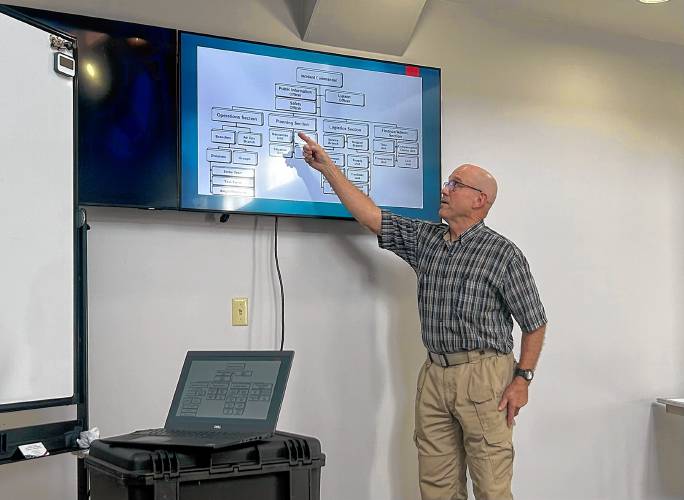Shelburne officials talk emergency preparedness

Shelburne Emergency Management Director Tom Williams invited elected and appointed officials to gather during two emergency preparedness sessions at the Shelburne Police Station last week. STAFF PHOTO/BELLA LEVAVI
| Published: 09-18-2023 2:01 PM |
SHELBURNE — Town officials are getting up to speed on their emergency preparedness plans by learning the basic principles of the National Incident Management System (NIMS) and considering how they might play a role during potential disasters.
“We are working to save lives and protect property,” Emergency Management Director Tom Williams said. “Those are the two major responsibilities of emergency management.”
Williams invited elected and appointed officials to gather during two sessions at the Shelburne Police Station last week, where he explained that NIMS is a systematic, proactive approach to guide all levels of government to work together to “prevent, protect against, mitigate, respond to and recover from” the effects of emergencies.
NIMS was first implemented through the Federal Emergency Management Agency (FEMA) after Hurricane Katrina inflicted devastation in New Orleans in 2005. It provides a structure that can be carried out on the national level to respond to global crises, but it can also be applied on the municipal level and can be helpful during responses to disasters ranging from July’s heavy rainstorms to train derailments.
Specifically, the system aids with resource management, command coordination and communication by using an Incident Command System. This system creates common organizational structures, allowing entities to easily work together during times of need, providing a clarified chain of command and outlining common language to use between groups.
“If we had an intense storm and needed to communicate with neighboring towns, we could communicate with the same structure and common terminology,” Williams explained. “It allows for the integration of resources.”
Williams said it is important to document all expenses during emergencies like labor, overtime spending, sandbags, gravel, trucking and contracts with private companies. He explained the Massachusetts Emergency Management Agency (MEMA) has a threshold to reimburse damage expenses, so tracking expenses is particularly important later on. Supporting sections of the Incident Command System include operations, planning, logistics and finances.
A big aspect of the NIMS system is providing effective communication. Strategies for disseminating information include setting up a municipal text alert system, a MEMA-controlled emergency text system that can provide information to any person in a prescribed radius, effectively using social media and communicating with news outlets.
Article continues after...
Yesterday's Most Read Articles
People in attendance during the first seminar included Arms Library Director Laurie Wheeler, who said she can help communicate with residents using library resources: newsletters, posters and word of mouth. Mohawk Trail Regional School Principal Chris Buckland mentioned he can communicate with school families and the community can make use of the school as an emergency shelter. Additionally, Energy Committee member Gregory “Jeff” Boettner said his committee can assist with preventative measures by strengthening the town’s infrastructure.
“If a small sliver of the community gets to represent themselves in the planning process, they get included and it creates more resiliency,” Williams said. “We in New England have a great tradition of looking out for our neighbors.”
Bella Levavi can be reached at 413-930-4579 or blevavi@recorder.com.

 UMass graduation speaker Colson Whitehead pulls out over quashed campus protest
UMass graduation speaker Colson Whitehead pulls out over quashed campus protest UMass student group declares no confidence in chancellor
UMass student group declares no confidence in chancellor Four Rivers Climate Club organizes litter cleanup, panel on environmental activism
Four Rivers Climate Club organizes litter cleanup, panel on environmental activism Retired police officer, veteran opens firearms training academy in Millers Falls
Retired police officer, veteran opens firearms training academy in Millers Falls
